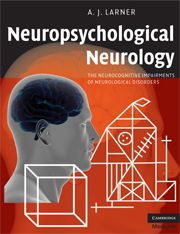Book contents
- Frontmatter
- Contents
- Acknowledgements
- Introduction
- 1 Cognitive function, neuropsychological evaluation, and syndromes of cognitive impairment
- 2 Neurodegenerative disorders
- 3 Cerebrovascular disease: vascular dementia and vascular cognitive impairment
- 4 The epilepsies
- 5 Neurogenetic disorders
- 6 Inflammatory, immune-mediated, and systemic disorders
- 7 Structural brain lesions
- 8 Endocrine, metabolic, and toxin-related disorders
- 9 Infective disorders
- 10 Neuromuscular disorders
- Index
- References
5 - Neurogenetic disorders
Published online by Cambridge University Press: 15 December 2009
- Frontmatter
- Contents
- Acknowledgements
- Introduction
- 1 Cognitive function, neuropsychological evaluation, and syndromes of cognitive impairment
- 2 Neurodegenerative disorders
- 3 Cerebrovascular disease: vascular dementia and vascular cognitive impairment
- 4 The epilepsies
- 5 Neurogenetic disorders
- 6 Inflammatory, immune-mediated, and systemic disorders
- 7 Structural brain lesions
- 8 Endocrine, metabolic, and toxin-related disorders
- 9 Infective disorders
- 10 Neuromuscular disorders
- Index
- References
Summary
Although great advances have been made in elucidating the genetic basis of neurological disorders in recent years, with profound implications not only for diagnosis but also for beginning to understand disease pathogenesis, nonetheless a clinical rather than a pathogenetic classification of disorders is used here, in part because the pathogenetic pathway from mutant gene to disease phenotype remains uncertain in many instances.
Hereditary dementias
Under this rubric, dementia syndromes with confirmed genetic basis, with or without additional neurological features, are included. Autosomal dominant Alzheimer's disease (see Section 2.1), frontotemporal dementia with parkinsonism linked to chromosome 17 (FTDP-17: Section 2.2.4) and hereditary forms of prion disease (Section 2.5.3) are discussed elsewhere, as are other genetic disorders which may result in dementia such as CADASIL (Section 3.6.2) and some of the hereditary cerebral amyloid angiopathies (Section 3.6.3).
Huntington's disease (HD)
The archetypal hereditary dementia is Huntington's disease (HD), although a number of the common neurodegenerative dementias may sometimes be inherited in an autosomal dominant manner (see Chapter 2). In his description of the disorder that now bears his name, George Huntington not only delineated the movement disorder, most usually chorea (cortical myoclonus and parkinsonism may also occur), the neuropsychiatric features, and the mode of inheritance, but also alluded to the gradually progressive impairment of the mind (Huntington, 1872). Cognition is one of the four characteristics, along with motor function, behaviour, and functional abilities, assessed by the Unified Huntington's Disease Rating Scale (UHDRS), which has now become the universal scale for measuring HD function (Huntington's Study Group, 1996).
- Type
- Chapter
- Information
- Neuropsychological NeurologyThe Neurocognitive Impairments of Neurological Disorders, pp. 125 - 156Publisher: Cambridge University PressPrint publication year: 2008



